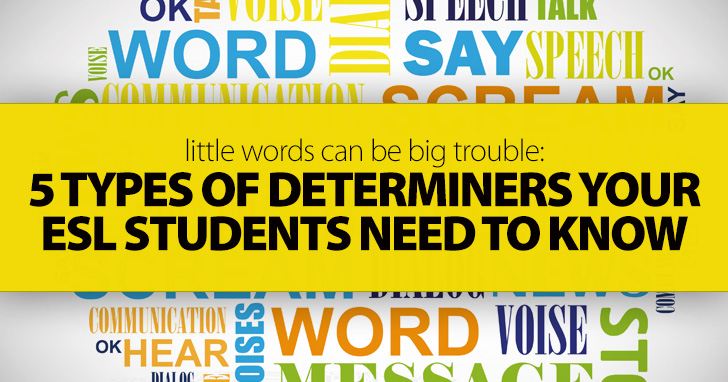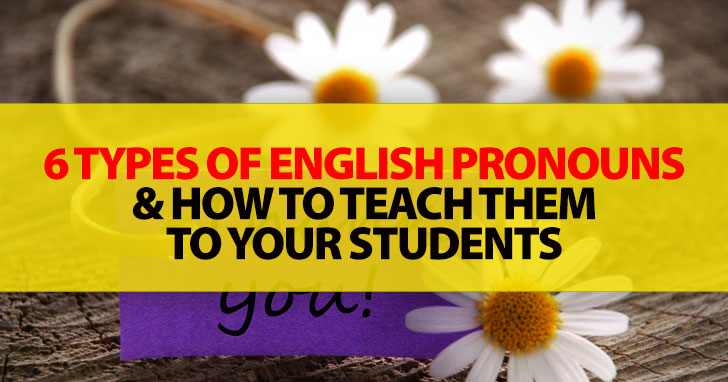Little Words Can Be Big Trouble: 5 Types Of Determiners Your ESL Students Need To Know


Pronouns change depending on person, number, and function in a sentence. We use different pronouns for people we know and people we don’t. We use pronouns to ask questions, to draw attention to certain objects, and to show ownership. It’s no wonder that pronouns are a topic we discuss frequently in ESL classes. So the next time you have pronouns on your to discuss list, here is a quick review to keep all those pronouns straight.

Personal pronouns are those that refer to people, places, things, and ideas. Personal pronouns are some of the first words ESL students learn because they are so frequent and important in speaking and understanding English. Personal pronouns can be divided up into two major categories. Some personal pronouns are subject pronouns (I, we, you, he, she, it, they) while others are object pronouns (me, us, you, him, her, it, them). It is important for ESL students to know the difference between subject and object pronouns. Subject pronouns function as the subject of the sentence. Object pronouns function as the object of a verb or a preposition. It is not uncommon, particularly when a pronoun is the object of a preposition, for students to incorrectly use a subject pronoun. In fact, native speakers do it, too. One particularly confusing use of subject and object pronouns comes when they are part of a compound subject (or object). Because they are linked with another noun in a compound subject, it is easy to accidently choose the correct pronoun.
Practice: Give your students several sentences that contain compound subjects and compound objects of verbs and prepositions used both correctly and incorrectly such as the ones below. Have students read each sentence omitting one of the nouns in the compound portion. If the correct pronoun is in the sentence, it should still make sense when the other part of the compound portion is omitted. If the incorrect pronoun is used, students should be able to tell from the context.
Me and my sister are going to the movies. (incorrect)
He gave the cupcakes to Jackie and me. (correct)
You’ll have to go through I and Adam to get to him. (incorrect)
Alison and I will have chemistry together next year. (correct)
Possessive pronouns show ownership. Some possessive pronouns are used with a noun in a sentence to show ownership (my, our, your, his, her, its, their). Other possessive pronouns are used independently (mine, ours, yours, his, hers, its, theirs), that is, they do not appear alongside a noun.
Practice: Give students several sentences that use possessive pronouns, both with nouns and without, but omit the pronouns from the sentence. Have students work with a partner to decide which pronoun correctly completes each sentence.
Indefinite pronouns do not refer to a specific person or thing. They are used in general statements or when a specific noun is not known. Most indefinite pronouns are singular (anybody, everybody, somebody, neither, someone, something, etc.) while others are plural (both, few, many, several, etc.). Some indefinite pronouns can be either singular or plural (all, any, most, none, and some).
One common area of confusion for ESL students is between the use of who and whom, both of which are indefinite pronouns. Who is a subject pronoun. It is used as the subject of a sentence. Whom is an object pronoun, and it is used as the object of a verb or a preposition. The use of who and whom is traditional grammar. However, as languages do, English is experiencing a shift in the use of who and whom. Whom is generally replaced by who in casual writing and in spoken language. Native speakers generally only use whom in formal writing and sometimes not even then. You will have to make sure your students know the difference between who and whom and are able to use them grammatically. Whoever and whomever follow the same pattern. Whoever is a subject pronoun. Whomever is an object pronoun. Native English speakers tend to use whoever except in very formal writing.
Practice: Here is a good worksheet for practicing correct usage of who and whom.
Another type of common pronouns is demonstrative pronouns. This, that, these, and those are demonstrative pronouns in English. Be sure your students do not confuse demonstrative pronouns with demonstrative adjectives (also this, that, these, and those). Demonstrative pronouns take the place of a noun. This is fun. While demonstrative adjectives are used to modify nouns. This game is fun.
This is generally used to refer to a single object that is near the speaker. That is generally used to refer to a single object that is farther away from the speaker. Likewise, these is generally used to refer to multiple objects that are near the speaker. Those is generally used to refer to multiple objects that are farther away from the speaker.
Practice: Using a standard six-sided die, either in groups or as a whole class, have students roll a number. Students will need to make a sentence correctly referring to something in the classroom using the demonstrative pronoun they rolled. 1: this, 2: that, 3: these, 4: those, 5: roller’s choice, 6: use two demonstrative pronouns of your choice in one sentence.
English has several reflexive pronouns, and as their name suggests, they refer back to nouns or pronouns used earlier in a sentence. English reflexive pronouns end in self or selves.
Here is a worksheet you can use with your students to review and practice reflexive pronouns.
Interrogative pronouns are those pronouns which are used to ask a question: who, whose, whom, which, and what. You can find a quick review of interrogative pronouns here.
Pronouns are an important part of the English language. If you take the time to teach and review the different types of pronouns used in English, your students will be sure to benefit.